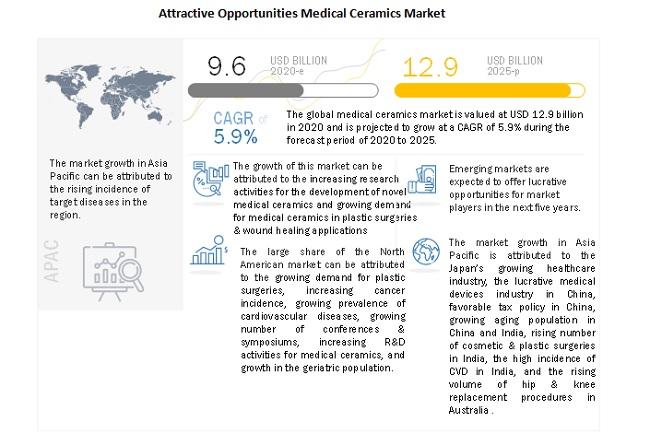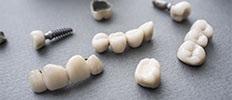According to market research report, "Medical Ceramics Market By Material (Zirconia, Alumina, Hydroxyapatite, Glass, Bioresorbable, Bioinert, Bioactive, Piezoceramics), Application (Dental, Orthopedic, Cardiovascular, Diagnostic, Surgical Implants, Dermal Fillers) & Region - Global Forecast to 2025", The global medical ceramics market is projected to reach USD 12.9 billion by 2025 from USD 9.6 billion in 2020, growing at a CAGR of 5.9% from 2020 to 2025. The growth of the global medical ceramics market can be attributed to factors such as increasing research activities for the development of novel medical ceramics, growing demand for medical ceramics in plastic surgeries & wound healing applications; the rising number of hip & knee replacement procedures; and the increasing demand for implantable devices drive the growth of the medical ceramics market.
The growing healthcare industry in emerging economies and increasing research activities in medical ceramics for nanotechnology and electronic device applications are likely to offer lucrative growth opportunities for players in the medical ceramics market. However, factors such as stringent clinical & regulatory processes and unfavorable healthcare reforms in the US are expected to restrain this markets growth.
Moreover, issues related to reparability & recycling processes and the shortage of skilled surgeons & dental professionals are major challenges adversely impacting this markets growth. The growth of the market is also expected to slow temporarily during the forecast period due to the COVID-19 pandemic.
Download PDF Brochure @ https://www.marketsandmarkets.com/pdfdownloadNew.asp?id=237425129
Hydroxyapatite has high biocompatibility, bioactivity, and osteoconductivity; making it suitable for a wide range of applications, such as a bone void filler for the orthopedic, spine, maxillofacial, and dental surgery; restoration of periodontal defects; orthopedic and dental implant coating; bone-tissue engineering; and gene delivery.
Due to its bioactivity, hydroxyapatite is an alternative to allogenic & xenogeneic bone grafts, resulting in shorter healing times. Additionally, it is used as an injectable cement or coating on titanium & titanium alloy implants to reduce the implant rejection rate.
The dental applications segment accounted for the largest share of the medical ceramics market in 2019. This segments large share can be attributed to the increasing number of cosmetic dental procedures and dental implant procedures across various regions and rising periodontal disorders.

Medical ceramics are key components in the manufacturing of various implantable devices, such as orthopedic implants (artificial hips, knee, shoulder, wrists, fracture fixation, and bone grafts), cardiovascular implants (heart valves, pacemakers, catheters, grafts, and stents), dental implants (enamels, fillings, prosthetics, and orthodontics), and hearing implants (cochlear implants).
